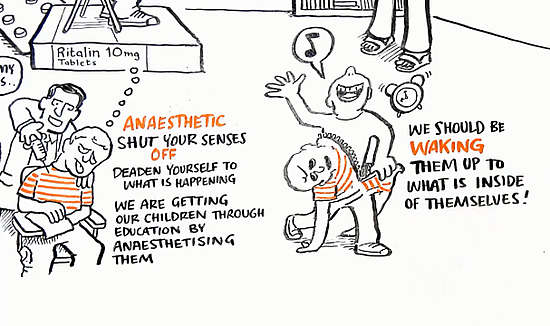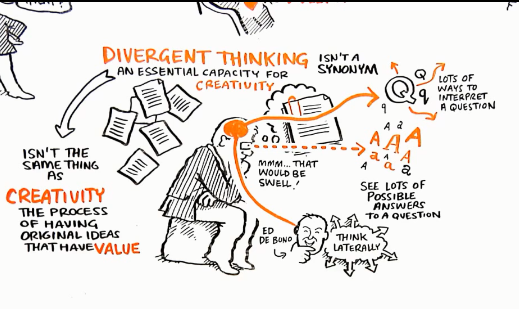1 01: BEING THERE
INTRODUCTION
READING FOR PLEASURE
What do you mean, “reading for pleasure?”
Remember, there are no tests or exams in this class. I don’t come to you as a didactic educator—the sage on the stage. No. I may be old, & I may be a ‘theatre’ professor—but I (greatly) dislike the stage. I’m an old-school media hack. I want to teach you. I want to share my ideas and thoughts. I want to share HOW I come to ideas and thoughts. I hope you want to share your ideas. I want to know what you think. I want to know how you think—and then, I can encourage you to grow.
The sage teacher (—those didactic educators) wants to make sure you know all the answers by testing your ability to recall information. They lecture at you, making deposits into your brains, and want to see a return on their investments. The model of education that you are (most likely) accustomed to is akin to modern banking. I am not a banker. I do not think you are a client, or that I’m a faceless institution looking to take you for a percentage. I don’t want to value information. Information is everywhere. You know that. If you need to recall a piece of information, look it up on your phone. Soon, the microchip will be implanted into human brains, so—in my imagination, the value of information is increasingly useless. It’s all there. How do you know what to look up? Think I am going to tell you? Please don’t expect me to tell you what to know, what to believe, or the right answer. I don’t have many answers that are not open to your disagreement (framed as a persuasive argument). In fact, I like to say: I may disagree with you and will defend TO THE DEATH your right to your opinion. And I will. . . defend that right. And I will, in this course, argue that some opinions are better than others. Yes. You may have your opinion, but not all opinions are equal. Sorry-not sorry.
If I was a banker, this would be so much easier. Count. Deposit. Withdraw. Count. However, I admit it now, I am not such a fan of numbers. I prefer words. Is that reasonable? So, I resist all modes of banking (as a metaphor for my teaching practice). Instead, I see myself as a GARDENER. Every single one of you, in my imagination, are beautiful, living, sentient flowers. I love flowers. Flowers are always appropriate. Maybe you’re a tree. I love trees. Where would we be without trees? I’m a gardener. My job, then, is to do my best to care and nurture—so you grow. And I sincerely hope you grow into the most beautiful flowers or the tallest, strongest trees. Flowers and trees do not disappoint. They grow in mysterious and unique ways and do not expect. Flowers don’t count. Trees have no need for banks—no coins, currency, or clients.
The first set of learning activities and first part of our open educational resource (OER) is called “Being There.” I take the name from Jerzy Kosinski’s (1970) satirical novel. In this story, the hero is a simple gardener named Chance. When I first read the book, I wondered whether Chance had a mild intellectual dis/ability. In the book, he unwittingly rises in the American political world. Everyone wants to know what he thinks. To change the world, you don’t need to be a rocket scientist—a simple gardener can make a different. A gardener can change the world. Kosinski convinces me that everyone has something to offer the world. Jerzy Kosinski is a fantastic storyteller. I also recommend his first novel, The Painted Bird (1965), a hauntingly beautiful novel that still creeps into my dreams. Reading is one of my favourite things to do. I get lost in a book. Books stay with me. I also love television and movies and all sorts of stories. And want to celebrate reading stories as one of the best ways to learn about the world. Reading means you understand language and language is necessary for the expression of ideas. If you want to grow and learn new things, read books. Be curious. You tend to “think” and “write” according to your reading habits. Want to be a storyteller? Read good stories. Want to be a rocket scientist? You’ll have to read a lot more than stories, and still, reading good writing helps you know how to write; how to use language; how to think; how to communication your thinking to others. You are what you read. Consume books and your mind will grow healthy and strong.
I have been teaching long enough to know that you are not going to read everything I suggest. If there was a test, you’d read as much as you thought necessary to get the number. Count. Deposit. Withdraw. Count.
And I warned you—I am not such a fan of numbers right now. I’m a gardener. No counting involved. To promote your curiosity; to respect your interests; to celebrate how you construct meaning in and of the world—I have many reading suggestions. This course also has many short videos, talks, and other resources that I find very interesting. This week I recommend Ken Robinson’s short video Changing Educational Paradigms. What metaphors help you understand your learning experiences? AReyou a banker? a gardener? Maybe you’re a chef? These metaphors help make sense of the world.
Don’t feel like you need to get through everything. Rather, recognize that each of the required assignments asks you to connect and source your thinking or evidence or support—from some of the course resources. So read through the key words for each week. Read through the course outline to see what interests you. And to get you started I selected four very different readings. You might want to read them all. You might skim them and say. . . wtf. I hope you trust that there’s something in all the resources from which you can learn. You choose what work you will do in this course. Welcome to choose your own adventure—your learning adventure. Learning is an adventure, don’t you think? Come to this experience with a sense of curious adventure. Together, we are going to play with language, ideas, words, images, media, stories. . . Let’s play together. To get started, I suggest you read through the course outline and the assignments. Then turn to some of the readings and let them invite you into their worlds. Get lost in the language of these writers, thinkers, creators, and educators.
Like a good gardener, I give you lots of choice. I give you agency to learn. I give you opportunities to learn how to learn and how to love learning. It’s one of the greatest things about learning. Learning happens every day (if you let it). Rather than tell what to memorize about media—this course shares several (hundred? thousand?) aspects of media. Then you decide what to do with this information. There are no wrong answers. However, like opinions, some answers are better—better argued, more persuasive, more exact. You must know this—you want to improve your arguments, finesses your communication to persuade, and use precise language to get to the exact point. Along the way, I hope you find the materials interesting, challenging, and fun. To be curious and set out on a new adventure is the kind of play most find fun.
Throughout all the materials, you’ll find my stories and letters. These words try to capture your attention and demonstrate what descriptive and reflective writing looks and sounds like. Each assignment asks you to reflect on your learning—giving you an opportunity to describe the work you’ve completed. What did you do? What did you experience? What did you learn? How? & Why does this learning matter? All learning matters. My words may or may not persuade you. I share my words and worlds. I look forward to learning what you think. So get reading. Read for pleasure. Read for yourself. Who else matters more?





WELCOME | AANIIN | SHALOM
AANIIN [Ojibwe for Hello; Welcome; Greetings]
SHALOM [Hebrew for Hello; Goodbye; Peace]
Welcome to University. Welcome to September. Welcome to adulthood.
I hope you’re ready because your whole world is about to change.
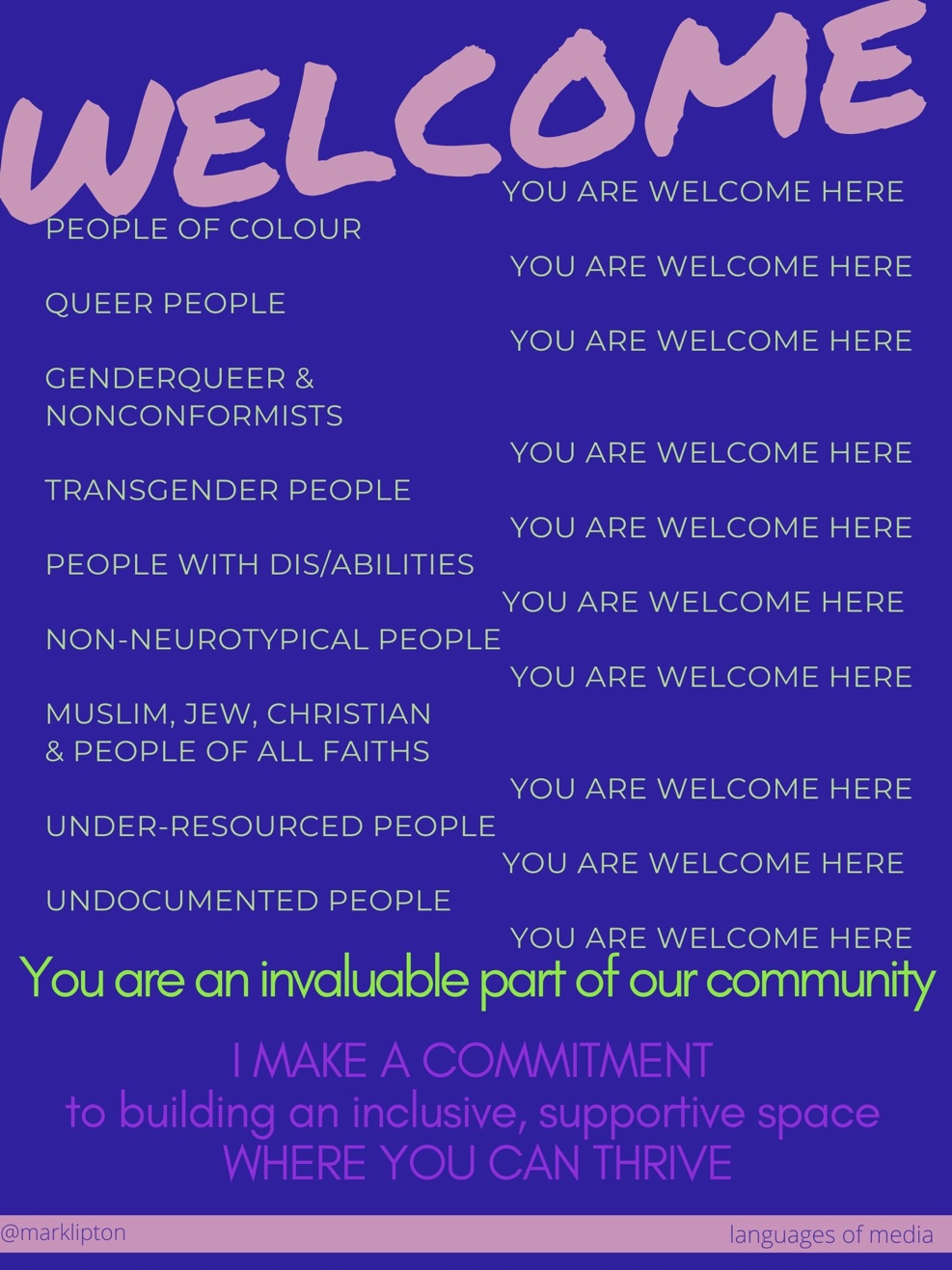

WHY WELCOME WONDER
Hi. Welcome. Let’s begin.
FIRST, I don’t have all the answers. Sometimes questions seem more interesting. Yes, I like to ask a lot of questions. I am one who likes to WONDER. Invite AWE, SURPRISE, and INQUIRY into your approach to learning. How can you make this course INTERESTING? Are there things you can do? I wonder. . .
TWO: You are not required to answer all my questions. I recommend you consider what I ask. I hope you are open to studying these questions—before you rush to answer anything.
—after each question, I suggest a pause. Contemplation is SLOW. WE are in no rush. Deadlines are suggestions. Contemplate what that means. . . slowly.
Invite WONDER. Contemplate slowly.
THREE: Bottom-Line-Up-Front
When asked, I tell people the bottom-line upfront. As long as necessary & as short as possible. I promise to do my best to be direct and present asynchronous course information as clearly and simply as possible. And if you have a question or want to connect—there are members of the teaching team who will reach out to you. Take a moment or take advantage: this course has several compassionate educators waiting to connect with you.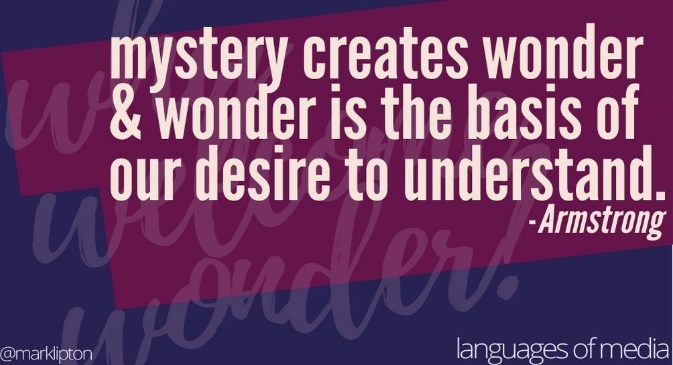
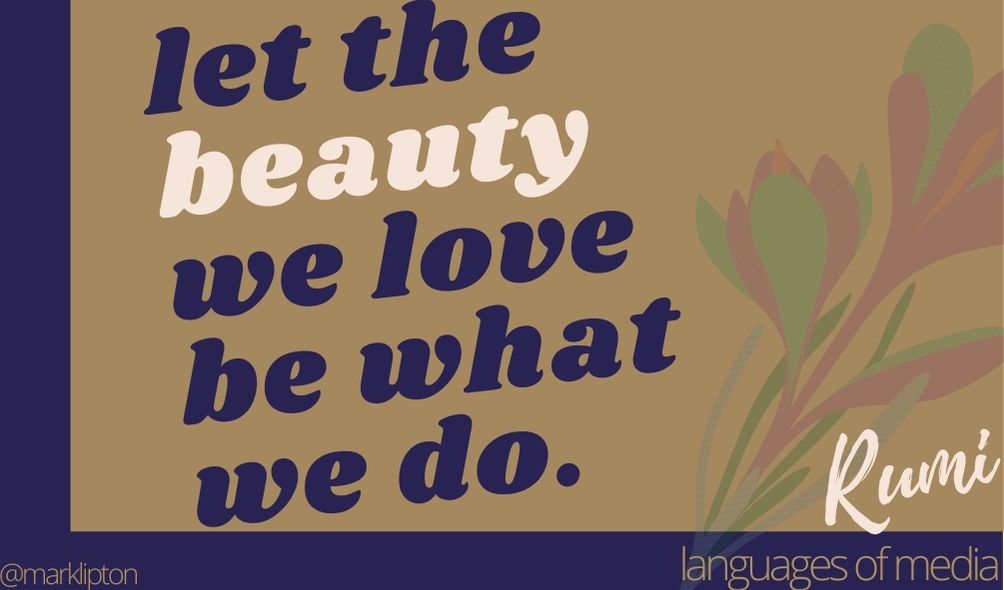

YOU ARE GREAT
A key outcome from The Languages of Media is to fully understand the powerful and insidious nature of media messages & HOW TO RESPOND with meaning reflecting values you hold dear. By that statement, I point to the language habits and visual tendencies (i.e., the immediate images that come to mind) that move your life forward.
Moment to moment, how do you measure your life? How can you be sure you are moving? Moving forward? Moving toward and not against. Is your life somehow being PUSHED forward? How is that working for you?
Now I ask, how attached are you to your communication devices? Your phone has enough power to send a rocket to the moon. Do you know how? Maybe building rockets isn’t part of who you are or who you want to be.
Present to the future.
Moment to moment.
Your brain somehow encodes the actions that move your day, what you do, and how you think. It’s all in there. Your utterances and meanings are based on your unique past experiences.
You live in a world. You encounter other people. You probably remember driving in a family car or a beautiful sunset. You have probably consumed food in an establishment or created imaginary worlds in the comfort of your bedroom. All these parts of your past direct who you are and how you are in the world.
& you are great
AS YOU ARE.
I am just asking questions. For example, what parts of your past world are encoded in your head?
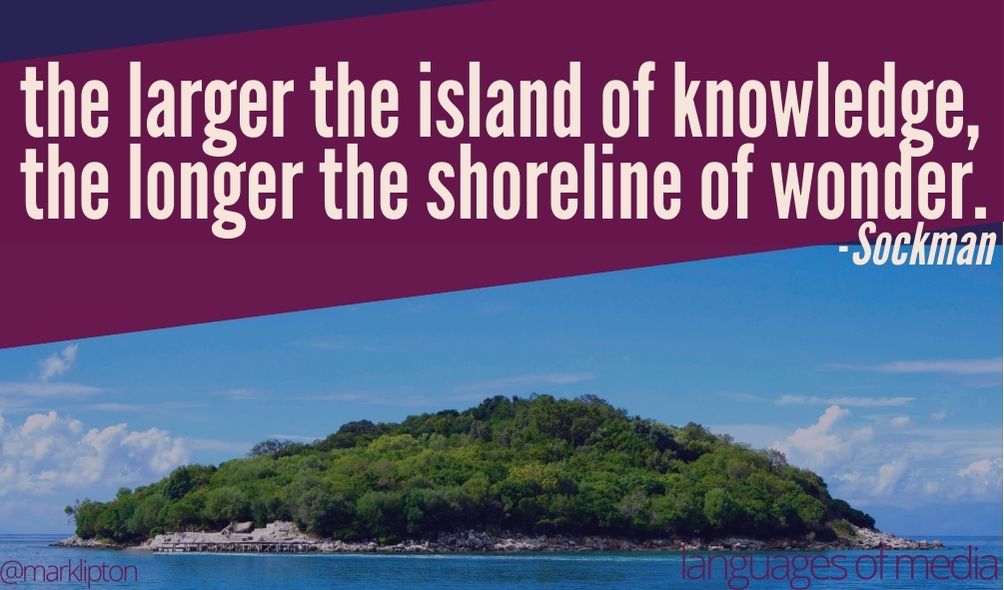
What parts of your world connect to capitalist ownership structures?
&
What parts of your world connect to public-facing corporate transactions?
&
What parts of your world connect to forms of brand marks, displays or spectacles?
Golden arches? Xbox? Disney? Hockey? Love? Pleasure?
What’s your thing? What’s your sh’peel? (That’s my Yiddish grandmother speaking. Her voice comes forth throughout this work–as part of my past experiences, her words help me understand my world.)
Which powerful brands are in your consciousness? Or is it your unconscious?
How many media messages are stuck in your mind? How much cognitive space to you give away to our capitalist, consumer-oriented social world? When you make space for symbol systems owned and controlled by larger capitalist institutions, these systems—their infrastructures, platforms, and ongoing strategic symbolic media messages have the power to contain and control social actions, human behaviour –your behaviour and ways of thinking and knowing.
Before going any further, I remind you: I do NOT know all the answers. This is less a book about answers. Instead, you are asked to consider how and why and what for and what’s next. . .
DECISION MAKING: DECISIONS BY DESIGN
Welcome to university. What a difficult time to be going to university. The world is in crisis.
The world is experiencing a collective trauma. You are not alone. You are at an intersection.
DECISION MAKING drives information transmission.
DECISION MAKING drives meaning-making.
Thank you for deciding to take this class. I want to talk with you about decision making. You must make thousands of decisions every moment. In a world of unprecedented media changes — the need for DECISIONS-BY-DESIGN is paramount.
We are living in times of information GLUT. That means too much information.
How do you know what to pay attention to? What is real? What is fake? How do you manage living in a world of information overload?
Over-communication — or too many media messages, is one strategy for controlling consumer behaviour. Media messages are so insidious, and these messages live inside all our heads. Media messages are living inside your head; and these messages guide your decision-making processes. Sometimes, you make choices based on what’s good for powerful media— not what’s good for you, for your community, for your life.
Most people don’t understand the insidious nature of media messages and the extent to which we give away our power in exchange for a little bit of pleasure and leisure. We are amused. We are amused and will be amused until our death.
You know what, the state of being amused is NOT the best way or the only way to go through life. LIFE isn’t just about being amused. Now I ask you: Have you decided what you want from life? Can you name those values that you decided to take on and carry with you throughout your life?
Here are some of my core values: I believe in maintaining a growth mindset; in being a changemaker; open & meaningfully connected. My integrity is tied up with my values for transparency, flexibility, authenticity, and a real commitment to compassion for myself, for others, and for the world. I like learning and encourage curious and creative play; I like to solve problems; I like seeing a bigger picture.
What are your values?
What decisions will you make to uphold the integrity of those values?
Most of your daily decisions are the result of unconscious processing. Like signals that tell your body what you want, how you want it, where to go, how to get there. . .
However, you have the agency to slow down some of those unconscious processes. To make sure that you’re making the right decision. Whether you’re aware of it or not, you’re responsible for every decision you make. With choice comes responsibility.
Access to higher education also comes with a responsibility . . . This adult thing —it means you are increasingly responsible. Modern life is full of choice. It’s overwhelming to have too much choice. Sometimes making difficult decisions leaves you frozen. That feeling when you slam on the brakes. You prepare for danger at every corner. This is referred to as a state of hyperarousal.
You aren’t making any mindful decisions. You can’t! Your primitive brain, or reptilian brain, is conditioned to look for escape. Often this state of hyper/hypo freeze means you cannot make any decisions. Your conscious ability to make decisions requires your full attention. By activating your executive brain functions, you are conscious of words, ideas, thoughts, and feelings.
YOUR CONSCIOUS MIND IS AN ISLAND IN A SEA OF RAPIDLY MOVING, AUTOMATIC PROCESSING.
You brain/body never stops. But this doesn’t make decision making any easier. In fact, it’s very easy to fall into unconscious patterns of habitual behaviour that help us make ongoing decisions required for daily life. One common approach is to avoid any decisions altogether.
You decide not to decide —to defer. Do you recall Hamlet’s great character flaw? Hamlet’s equivocation –should he do this; or should he do that? Hamlet, one might say, deferred himself to death; his equivocation or the inability to decide is what led to his ultimate demise.
In this class, my arguments focus on how media messages work to control and manipulate your behaviour, your actions.
You might think you are immune — but let me tell you, NONE of us are immune.
INSIDIOUS MEDIA MESSAGES
ARE YOU USING MEDIA?
OR ARE MEDIA USING YOU?
In this class, I will point out for you, how insidious message messages are, how we have made our illusions so real and so vivid, we can actually live inside our illusions. We do live in them. We have made our illusions, our spectacles and our fantasy so real, so dimensional, we can live in these elusive illusions. We are the most illusion’ed people on earth.
I’m here to pull you back to REALITY.
It’s time for you to admit that media has gotten into your head. In this class we will build strategies to get media out of your head. I want you to know how to build your own system of media languages so that you can control your life and your world. Stop letting media use you.
You use MEDIA every day & yet MEDIA is mostly using you.
Do you see how? Do you know how? Do you know what to do about it? THERE IS A LOT you can do. Resistance is an option. CHANGE is possible.
We are going to learn how to recognize these processes of cognitive takeover. How we surrender our cognitive powers to media. We are going to talk about how we can change to live the lives that we really want!
LAUGHING PLANNING
My instructional plans ask all learners to design an alliance. To meet the goals of this alliance, all learners are asked to set up [plan] a weekly schedule that carves out TIME and SPACE to engage with course materials. This includes an agreement to hold regular reading/viewing times AND creating/reflecting times.
Student success invites learners to find these LANGUAGES OF MEDIA experiences as engaging and fun and challenging.
I hope you can tell that this course has been carefully planned. This reminds me of one of those things my nanny used to say: “when you plan, God laughs.” She always finished this saying with a distinct giggle that still brings a smile to my face.
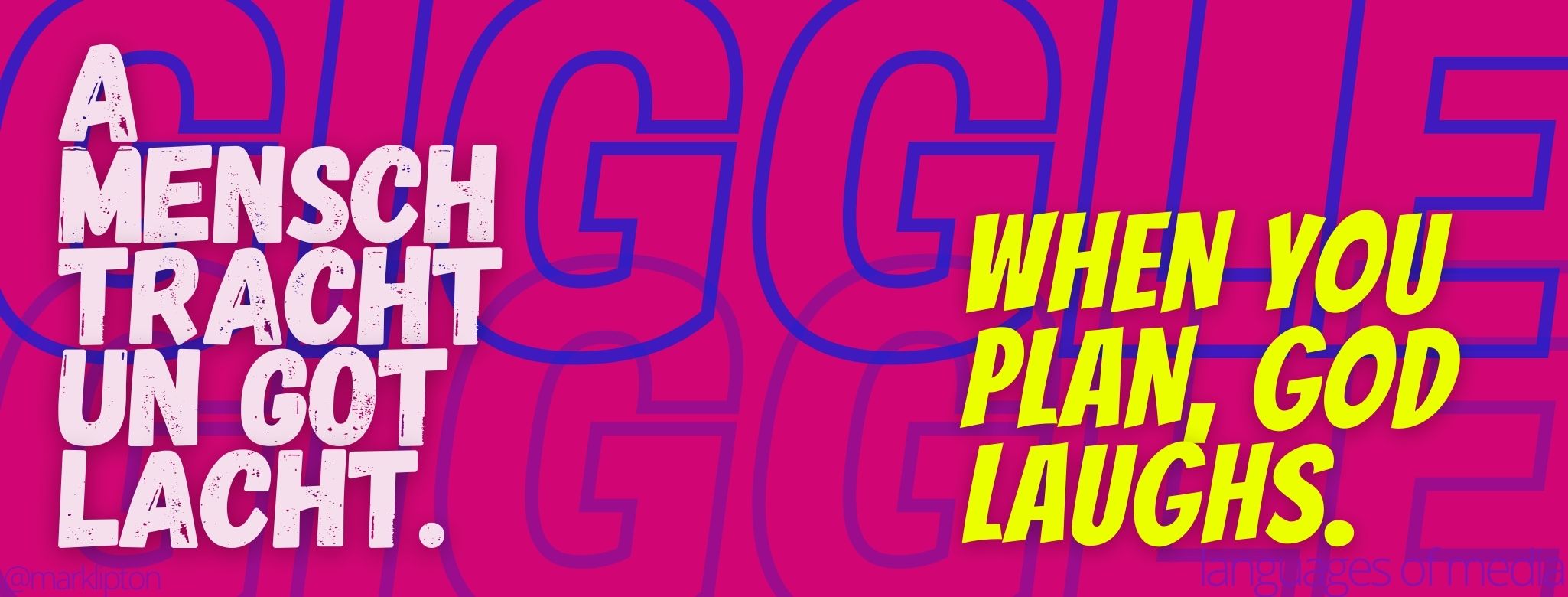 As a teacher, as an educator, as a compassionate human, I know everyone struggles. Life is a struggle. We all have our struggles. For students, sometimes that struggle is with the content or with their ability to engage with the course material. This course is aware of student struggles and tries to provide flexible options and flexible challenges that let students pivot, adjust, and re-adjust plans to maximize their own learning ecology.
As a teacher, as an educator, as a compassionate human, I know everyone struggles. Life is a struggle. We all have our struggles. For students, sometimes that struggle is with the content or with their ability to engage with the course material. This course is aware of student struggles and tries to provide flexible options and flexible challenges that let students pivot, adjust, and re-adjust plans to maximize their own learning ecology.
This open course is particularly challenging because I cannot follow my customary ways of attending to and observing learners at work and play. I don’t have the opportunity for social interaction, which I believe is so important to the learning process. I don’t have meaningful or authentic means of engaging learners, both in and out of the classroom. Nonverbal communication is silent.
NONVERBAL COMMUNICATION
Anthropologist, Edward T. Hall gives greater emphasis to the part played by culture in nonverbal communication. Similarly, British authority on the social psychological approaches to the study of nonverbal communication, Michael Argyle’s account focuses on the social & cultural contexts.
The human body is the main transmitter of nonverbal codes. As presentational symbols, these may include, for example, gesture, eye movement, or qualities of voice. nonverbal codes serve two functions: (1) to convey indexical information; & (2) interaction management. Argyle lists 10 codes & suggests the sorts of meanings that might be conveyed:
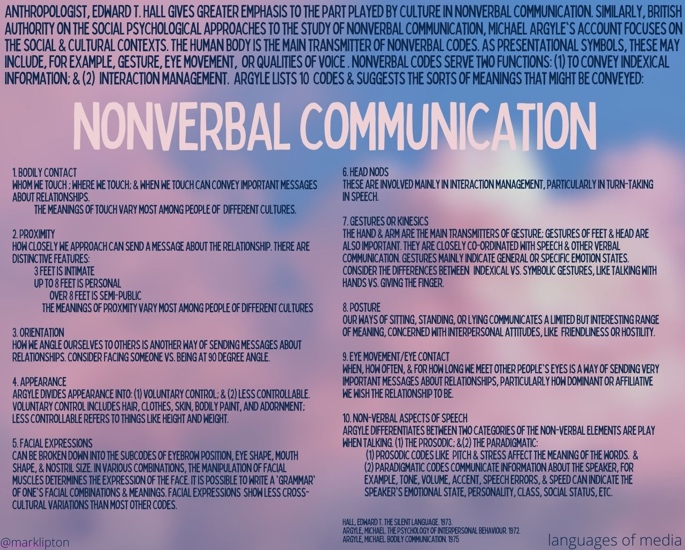
MY CHALLENGES
These are my challenges. As a result, I write directly: I want every student to succeed in this course. To this end, I focus on the learner as an individual.
Please do not try to get inside @marklipton’s head. There’s real chaos going on in there. Instead look at this course as an opportunity to invest in and exploit your own interests. I might not be able to observe your learning interactions, however, the choices you make in the selection of content and materials, and the ways you combine materials and reflect help me achieve a much closer understanding of you is an individual, as a human, your prior knowledge, your struggles, and your successes.
WE RESPECT YOUR LEARNING ECOLOGIES
Respect is a term that refers to courtesy and esteem for another person–an other’s points of view, in deference to someone else’s rights and positions. I am challenged by the critical goal of creating a respectful learning environment. I pledge to work with sincere respect when it comes to your health, cultural background, family situations and other factors that may impact your learning ecology. Imagine the extent to which my body language signals respect: I am making eye contact; I smile, my feet are firmly grounded, and I bring my passion for this work in my movement.
Within the context of your own learning ecology, I now invite you to think a little bit about your body. To what extent is your body language something you control? observe? practice? Online learning erases or divorces the body and somatic sensations in the body from learning.
I cannot pretend that your body language has wholly disappeared behind a screen. You are still a body. Imagine the extent to which your body language signals ‘respect.’ As you are working through this course, acknowledge the extent to which you respect the material, you respect learning, and you respect yourself as a learner. For me, physical distancing means I’m likely at home, sitting at my desk in front of my computer with screen and camera; and I’d like to highlight the respect I bring to my work by dressing in a kind of learning uniform (that is, not my pajamas); I am wearing my shoes; I brushed my teeth and combed my hair. I may not see another human today. But I affirm my dignity and my respect for this work by recognizing behaviours that symbolize professional work. As a learner, the work from this course represents your professional work.
I also bring my body language into this work. Forward in my chair, I am mindful of balancing on my two pelvic bones; my lower back has a small curve (lordosis) as I lift with my heart, tuck my chin. Smile. Breathe.
I offer 100% of my presence to this learning experience.
NOW, I ask the following question: not for me –I do not want to know your answer.
Do you feel 100% present?
HOW MUCH OF YOUR FOCUSED ATTENTION DO YOU BRING AND PRACTICE AS YOU EXPERIENCE THIS LEARNING OPPORTUNITY?
On a scale from 1 to 10. 10 means something like “I am going to do whatever I have to do to learn as much as I can possibly learn.” 1 means something like “I and going to do the bare minimum to achieve a grade.”
|
1 |
2 |
3 |
4 |
5 |
6 |
7 |
8 |
9 |
10 |
On this scale of one to 10; where are you now?
I would like to imagine that all of you are mindfully sitting with a dignified posture.
Relaxed.
Smiling.
Your face beaming with the attention of a perfect 10.
& I know things get in the way. I respect your struggle. I recognize that we all have a life.
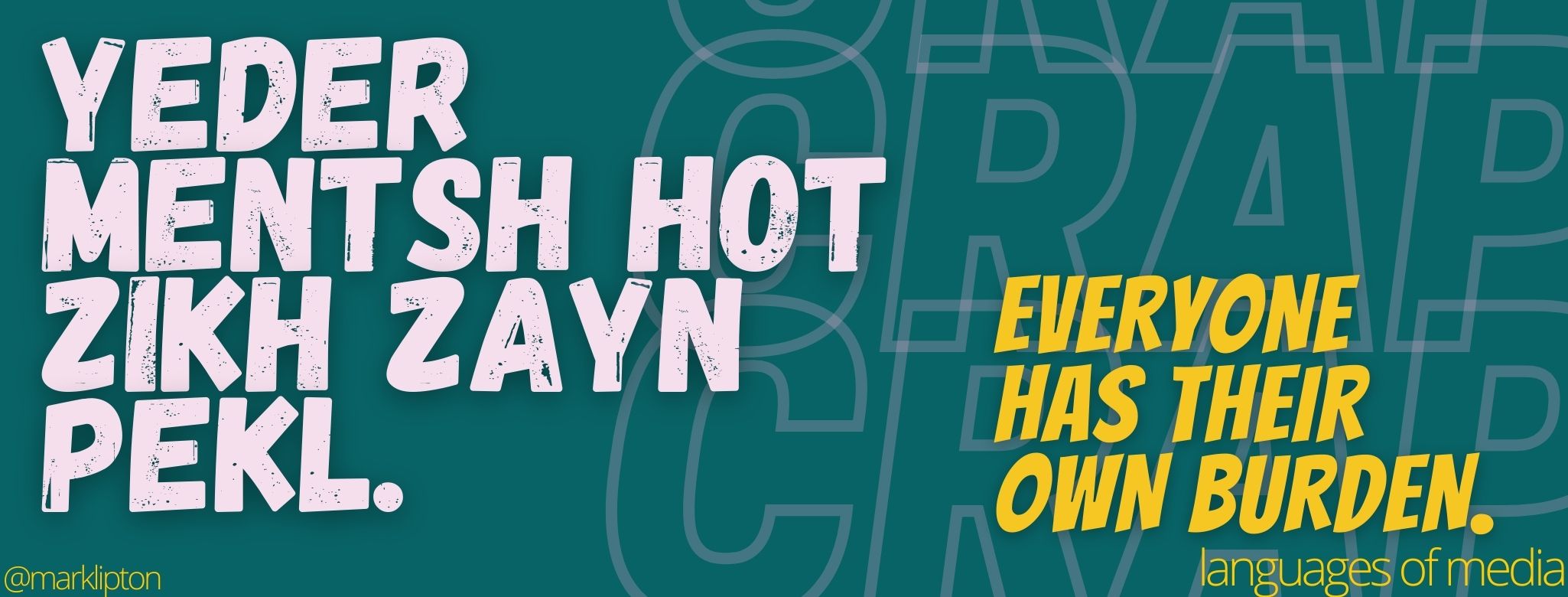
This course and its associated content may not be FIRST for you. Please keep in mind that, as self-directed learners, what you put into this class directly impacts your outcomes.
The more you give, the more you get. I HOPE this is an engaging and interesting course. I HOPE you are here for more than the simple act of achieving a grade. I really believe this class can change your life. Did you know you wanted to change your life? Are you ready for change?
The best way to manage change is to have an open mind and a flexible point of view.
I want to create safer and supportive learning environments, positive learning environments respectful learning environments, challenging learning environments. To this end, I look to you and your ability to mitigate this course content with your learning ecologies.
Your views of learning and knowledge can evolve. What do you bring to bear when considering the speed, stability, and authority of knowledge? Are you prepared for these beliefs to evolve as you progress through our course content?
For me, the key to creating a safer space is to always encourage open and honest communication, and to model this in my teaching. Please be candid about how you feel, what might be coming up and what is getting in the way.
Don’t humour me or go through the motions if I do or say something that doesn’t work or pisses you off. If you feel safe enough to share, we can both wonder and get curious together. How can I help establish the necessary trust to support our alliance? What can I do to convince you that your learning is a lifelong objective, not a destination?
For me, trust is strengthened by clarity and meaning; we can achieve shared meanings by asking questions and listening. Research consistently indicates that learners who believe intelligence or aptitude is increasable pursue the learning goal of increasing their competence; whereas those who believe intelligence is a fixed entity are more likely to pursue the performance goal of securing positive judgments or preventing negative judgments.
For example, see: Dweck, C. S., & Leggett, E. L. 1988.
A social-cognitive approach to motivation and personality. Psychological review, 95(2), 256.
![There is little evidence that learning in a classroom is better than learning online. Learning online may prove to be better! Over 1 million Canadian students complete an online course every year & student achievement matches face-to-face learning. Believe in online learning! Have more control over learning. Access & assess all materials at your pace Learn anywhere & at any time. Accelerate your learning if you want. Find a study-buddy. Turn in assignments on time. Find help. - you can do this. Make it so.]](https://books.lib.uoguelph.ca/app/uploads/sites/61/2021/08/image17-1.jpg)
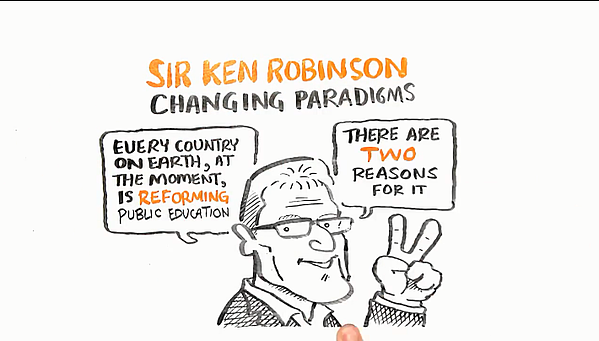
CHANGING EDUCATIONAL PARADIGMS
Changing Education Paradigms is Sir Ken Robinson’s digital ‘story’ (a public talk) about industrialization’s impact on education. Robinson look at the structures of education (what makes the educational paradigm) that lead to today’s dominant approach—what many refer to as the “banking model. By model, he refers to the paradigm to represent both the arrangements of our education system and its functions and impacts on kids, families, and society. Simply, Robinson identifies how current education systems fail. In doing so, he invites his audiences to consider other ways to think about education. By suggesting how to alter today’s education paradigms (i.e., the dominant structures that shape education and school experiences) to something more current and sustainable, Robinson wants education to meet the needs of the 21st century. Our society and most young people live in an ever-changing media saturated world.
The 21st Century, thus far, has already innovated education with radical advancements in learning technologies. But we live in constant distraction and disinterested in world events. This disinterest, when manifest in kids, is labeled attention-deficit / hyperactivity disorder (ADHD). I smiled when he declares how “We anesthetize young people at a time when the world is more exciting.” It is very likely that you or someone you know [or someone you would have met in this class – had we been able to all meet in person] takes some psychopharmaceutical or another. I prefer – I ask that you try to resist any language that reinforces medical diagnosis and the industrial-apparatus that makes modern medicine possible. Instead, I ask that you try to find the precise descriptive language to interrogate anything your doctor may have told you. How do you know, really, that your trusted doctor wasn’t a C student?
For today’s medical-industrial-complex, ADHD is a neurobehavioral or developmental disorder that impacts school-aged children, manifesting as restlessness, impulsivity, and a lack of focus. This can may impair children’s ability to learn. For Robinson, the increase
in learning technologies + standardised testing mirror ADHD prevalence.
To ENGAGE kids today encourage active, reflective, inquiring, and investigative learning strategies, taking time to explore ideas. Provide learning activities that creates learning opportunities. As a culture, people need to learn to be self-directed learners, so all people can be learning, constantly, what is required to better equip our world for life and work in the 21st Century.
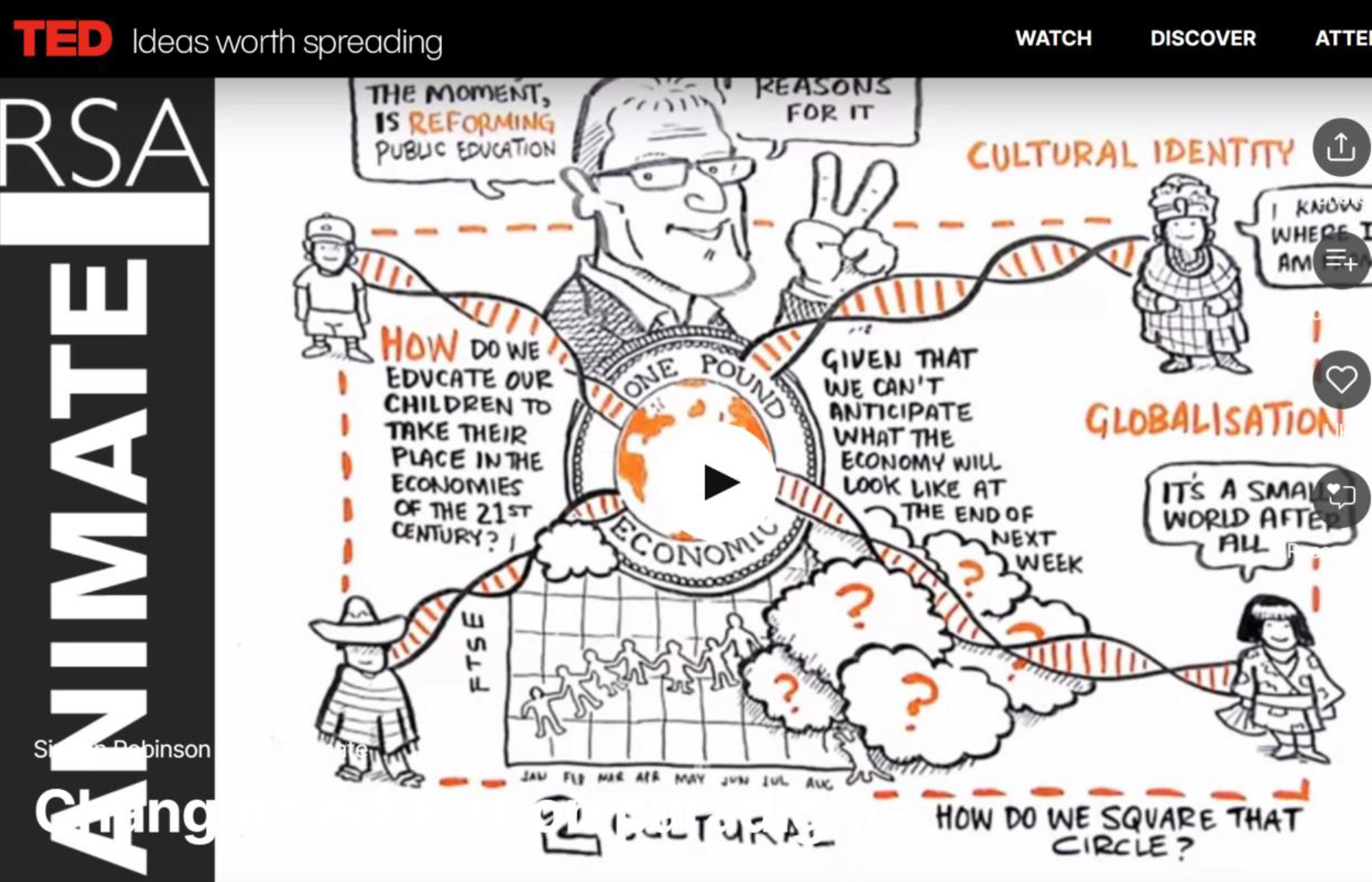
Sir Ken Robinson, Changing Educational Paradigms. RSA Animate. London, UK.TRANSCRIPTINTRODUCTIONEvery country on earth at the moment is reforming public education. There are two reasons for this. The first of them is economic. People are trying to work out how do we educate our children to take their place in the economies of the 21st century? How do we do that given that we can’t anticipate what the economy will look like at the end of next week, as the recent turmoil is demonstrated. How do we do that? The second is cultural. Every country on earth is trying to figure out how do we educate our children so they have a sense of cultural identity so that we can pass on the cultural genes of our communities while being part of the process of globalization? How do we square that circle? EDUCATION SYSTEMThe problem is they’re trying to meet the future by doing what they did in the past. And on the way they’re alienating millions of kids who don’t see any purpose in going to school. When we went to school, we were kept there with a story which is if you work hard and did well and got a college degree you would have a job. Our kids don’t believe that. And they’re right not to, by the way. You’re better having a degree than not the way. You’re better having a degree than not but it’s not a guarantee anymore. And particularly not if the route to it marginalizes most of the things that you think are important about yourself. So people say we have to raise standards if this is a breakthrough, you know, really, yes we should; why would you lower them? I haven’t come across an argument that persuades me of lowering them. But raising them of course we should raise them. The problem is that the current system of education was designed and conceived and structured for a different age. It was conceived in the intellectual, culture of the enlightenment. And in the economic circumstances of the industrial revolution. Before the middle of the 19th century there were no systems of public education, not really. I mean you could get educated by Jesuits if you had the money. But public education paid for from taxation, compulsory to everybody and free at the point of delivery that was a revolutionary idea. And many people objected to it – they said it’s not possible for many street kids and working-class children to benefit from public education, they’re incapable of learning to read and write and why are we spending time on this? So there’s also built into it a whole series of assumptions about social structure and capacity. It was driven by an economic imperative of the time but running right through it was an intellectual model of the mind, which was essentially the enlightenment view of intelligence; that real intelligence consists in this capacity for a certain type of deductive reasoning and a knowledge of the classics originally, what we come to think of as academic ability. And this is deep in the gene pool of public education; there are only two types people academic and non-academic; smart people and non-smart people. And the consequence of that is that many brilliant people think they’re not because they’ve been judged against this particular view of the mind. So we have twin pillars economic and intellectual. And my view is that this model has caused chaos in many people’s lives; it’s been great for some, there have been people who have benefitted wonderfully from it. But most people have not. Instead, they suffer this; this is the modern epidemic and it’s as misplaced and as it’s fictitious. This is the plague of ADHD. Now this is a map of the instance that ADHD in America or prescriptions for ADHD. Don’t mistake me, I don’t mean to say there is no such thing as attention deficit disorder. I’m not qualified to say if there is such a thing. I know that a great majority of psychologists and pediatricians think there is such a thing, but it’s still a matter of debate. What I do know for a fact is it’s not an epidemic. These kids are being medicated as routinely as we had our tonsils taken out. And on the same whimsical basis and for the same reason – medical fashion.
Our children are living in the most intensely stimulating period in the history of the earth. They’re being besieged with information and calls for their attention from every platform – computers, from iPhones, from advertising hoardings, from hundreds of television channels and we’re penalizing them now for getting distracted. From what? Boring stuff at school, for the most part. It seems to me it’s not a coincidence totally that the incidence of ADHD has risen in parallel with the growth of standardized testing. Now these kids are being given Ritalin and Adderall and all manner of things, often quite dangerous drugs, to get them focused and calm them down. But according to this, attention deficit disorder increases as you travel east across the country. People start losing interest in Oklahoma, they can hardly think straight in Arkansas and by the time they get to Washington they’ve lost it completely. And there are separate reasons for that I believe. It’s a fictitious epidemic. SCIENCE AND MATHIf you think of it the arts, and I don’t say this exclusively, the arts, I think it’s also true of science and of math, but I say about the arts particularly because they are the victims of this mentality currently particularly. The arts especially address the idea of aesthetic experience. And aesthetic experience is one in which your senses are operating at their peak, when you’re present in the current moment, when you’re resonating with the excitement of this thing that you’re experiencing, when you’re fully alive. An anesthetic is when you shut your senses off and deaden yourself to what’s happening. And a lot of these drugs are that. We’re getting our children through education by anaesthetizing. them. And I think we should be doing the exact opposite. We shouldn’t be putting them asleep. we should be waking them up to what they have inside of themselves. But the model we have is this. I believe we have a system of education that is modelled on the interests of industrialism and in the image of it. I’ll give you a couple of examples. Schools are still pretty much organized on factory lines; ringing bells, separate facilities, specialized into separate subjects. We still educate children by batches; we put them through the system by age group why do we do that? Why is there this assumption that the most important thing kids have in common is how old they are? It’s like the most important thing about them is their date of manufacture. Well, I know kids who are much better than other kids at the same age in different disciplines, or at different times of the day, or better in smaller groups than in large groups, or sometimes they want to be on their own. If you’re interested in the model of learning you don’t start from this production line mentality. It’s essentially about conformity and increasingly it’s about that if you look at the growth of standardized testing and standardized I curricula and it’s about standardization. I believe we’ve got to go in the exact opposite direction. That’s what I mean about changing the paradigm.
DIVERGENT THINKINGThere was a great study done recently of divergent thinking. It was published a couple of years ago. Divergent thinking isn’t the same thing as creativity, I define creativity as the process of having original ideas that have value. Divergent thinking isn’t a synonym but it’s an essential capacity for creativity. It’s the ability to see lots of possible answers to a question, lots of possible ways of interpreting a question to think what Edward de Bono would probably call laterally to think not just in linear or convergent ways. To seek multiple answers, not one. So there are tests for this, I mean, one kind of cod example would be people might be asked to say how many uses can you think of for a paper clip; one of those routine questions. Most people might come up with ten or fifteen. People who are good at this might come up with 200. And they’d do that by saying, “Well could the paperclip be 200 foot tall and made out of foam rubber?” “Does it have to be a paperclip as we know it, Jim?” Now they tested this and they gave them to 1,500 people in a book called Break Point and Beyond, and on the protocol of the test if you scored above a certain level you’d be considered to be a genius at divergent thinking. So my question to you is what percentage of the people tested of the 1,500 scored at genius level for divergent thinking. Now you need to know one more thing about them these were kindergarten children. So what do you think? What percentage at genius level? 80? 98%. Now the thing about this was it was a longitudinal study, so they retested the same children five years later aged 8 to 10. What do you think? 50? They retested them again five years later, ages 13 to 15. You can see a trend here, can’t you? Now this tells an interesting story because you could have imagined it going the other way, could you? You start off not being very good, but you get better as you get older. But this shows two things: one is we all have this capacity and two, it mostly deteriorates. Now a lot of things have happened to these kids as they’ve grown up, a lot. But one of the most important things that has happened to them I’m convinced is that by now they’ve become educated. They’ve spent ten years at school being told there’s one answer it’s at the back and don’t look. And don’t copy because that’s cheating. Outside school that’s called collaboration no but inside schools… This isn’t because teachers want it this way it’s just because it happens that way. It’s because it’s in the gene pool of education. MISCONCEPTIONThey have to think differently about human capacity. We have to get over this old conception of academic, non-academic, abstract, theoretical, vocational and see it for what it is – a myth. Second, you have to recognize that most great learning happens groups, in collaboration is the stuff of growth. If we atomize people and separate them and judge them that separately we form a kind of disjunction between them and their natural learning environment. And thirdly, it’s crucially about the culture of our institutions, the habits of the institution and the habitats that they occupy. |
MARK’S RULES OF COMMUNICATION MESSAGES
The focus in this course on languages points to our individual uses of language as a tool for communication, creativity, and critique.
| LANGUAGE IS THE MOST BASIC TOOL OF COMMUNICATION |
In my world, language is the most basic tool of communication; language provides the basis for all other media. We study how language works to understand the worlds of MEANING-MAKING. How do you find meaning in your world?
I see meaning making as a process of TRANSACTIONS. Languages do not mirror human experiences, instead, languages construct our worlds and worldviews. There is a world out there, but we can never know it as it “really is” only as we perceive. Our perceptions are limited by our senses & minds; and our minds are conditioned/limited by our language. Language is central to our thinking, behaviour, and lives; to understand any kind of communication or media, we must understand language
Here are some of general and pragmatic rules for understanding meaning-making and worldviews. Let me know if any of this help you.
1. One cannot not communicate.
As soon as you’re around other people, communication is inevitable.
2. Effective communication begins with asking, WHY?
3. SOME DOS & don’t
Don’t listen for leverage.
Don’t seek or search, attract.
Don’t command, communicate purpose.
Organize around performance, not obedience.
4. If a message can be understood in multiple ways, it will be understood in the most damaging possible way
5. We all want to know: what’s going on? What’s going to happen?
6. Smalltalk is not small at all.
It helps us connect, and it makes us human.
7. Being right & the solution to the problem are rarely the same.
8. All communication messages serve two functions:
ONE: content function: A message has content. There is a purpose to the message.
TWO: relationship function: The message serves to relay information about the sender and receiver’s relationship.
9. Signals and symbols are very different; they function in/as your response system/s.
10. The way you respond to a text:
says more about you than the text;
will always be based on your past experiences with similar texts.
11. Don’t confuse your maps with the actual territory.
We live in two worlds: The world of words; & the world of material things (non-words).
Words are like maps; words stand for things, like the map’s actual territory.
The more your maps correspond to territory, the better.
12. Words don’t have meanings. People make meaning. The word is not the thing.
13. Language reflects & conditions our thinking & behavior. Changing how we use language can change our patterns of thought & behaviour.
14. Your language defines your world.
15. A technology is to a medium, as a brain is to a mind.
16. Remember what’s a stake when looking at media messages, our very real world.
VER·I·SI·MIL·I·TUDE: THE APPEARANCE OF BEING TRUE OR REAL.
When media messages and forms capture the verisimilitude of the world, you are living in a fake world. Don’t forget how technology manipulates the world, leading many (most) to confuse reality with artifice.
IT’S THE REAL THING
![A long-shot of the Canadian Rocky Mountains. The sky is blue and a little cloudy; the mountains are snow-capped; the closer landscape includes lush green forest.]](https://books.lib.uoguelph.ca/app/uploads/sites/61/2021/08/image22-1.jpeg)
Like that time my husband took in the awesomeness of the Canadian Rocky Mountains and exclaimed, “it’s like a picture!”
I looked at my husband, astonished at his statement. I replied,
“No. It’s not like a picture. It’s the real thing.”
PERCEPTION: CAMERA/EYE
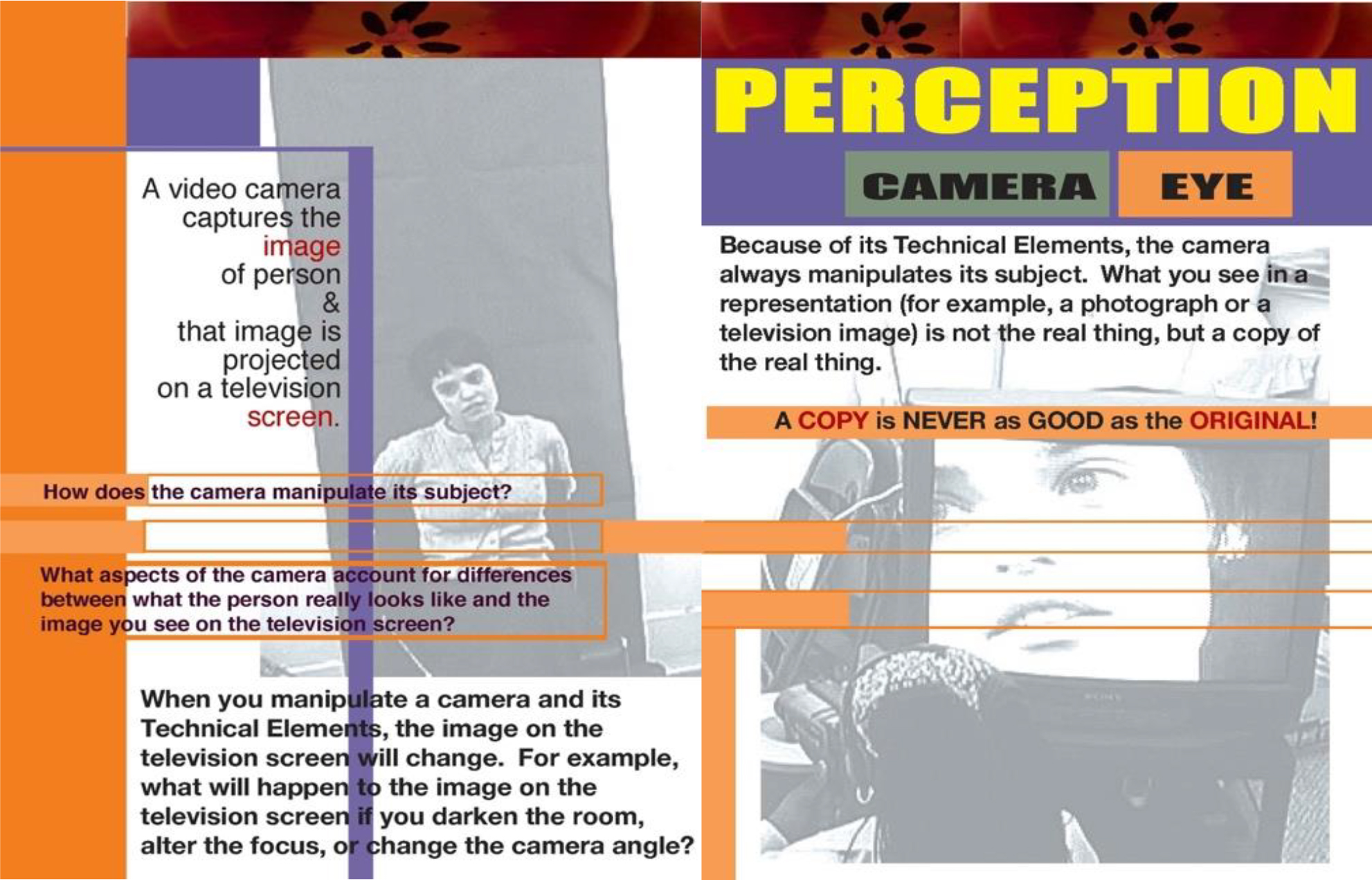
A COPY IS NEVER AS GOOD AS THE ORIGINAL!
A graphic image of a seated woman in black and white; bright orange and purple strips cut through the image and down the page. It reads, “A video camera captures the image of a person, and that image is projected on a television screen. How does the camera manipulate its subject/ What aspects of the camera account for differences between what the person really looks like and the image you see on the television screen?
When you manipulate a camera and its Technical Elements, the image on the television screen will change. For example, what will happen to the image on the television screen if you darken the room, alter the focus, or change the camera angle?“]
A COPY IS NEVER AS GOOD AS THE ORIGINAL!
SOME LAWS OF COMMUNICATIONS MEDIA
It’s not enough to list different media and say when they developed if you want to understand the relationship between media and culture.
What we need are some principles about how media evolve in particular cultural contexts.
Consider some of these ideas to understand the relationships between media and culture.
1. Media arise as attempts of humans to solve problems of information. Essential questions to ask are: “What and whose problem does a medium answer?
2. Those media survive and are most widespread that solve the greatest number of questions about information for the greatest number of people,
3. But humans are imperfect, fallible creatures; therefore, solutions to information problems are never completely adequate.
4. Every solution to a problem of information changes the state of information. Every change produces a new set of problems.
BELONGING
Learners can engage more fully in learning when a sense of belonging is a starting point in instruction. What do you need to feel accepted, respected, and valued? How can I enhance your sense of belonging?
I know this is important.
We talk about respect and diversity, equity, and inclusion – and BELONGING is often erased from social equations. By gosh, a real sense of belonging is a basic psychological need. I know from my own experiences of entering classroom and course settings; often I felt like my identities were underrepresented (and negatively stereotyped). I understand the psychological challenges of feeling different. Do all students face these challenges? I do not know.
Nonetheless, I try to bring my sense of compassion and acceptance to all students. I imagine that some of you are overwhelmed by a need to make sense of daily adversities and/or the state of our society. I know I felt this way. I feel a global lack of belonging and this comes with its own degrees of stress and threat. I hope you can hear this: I ACCEPT YOU.
I ACCEPT YOU.
I ACCEPT YOU.
I ACCEPT YOU.
![WELCOME: You are an invaluable part of our community. people of colour; you are welcome here Queer people; you are welcome here genderqueer & nonconformists; you are welcome here transgender people; you are welcome here people with dis/abilities; you are welcome here non-neurotypical people; you are welcome here Muslim, jew, Christian & people of all faiths; you are welcome here under-resourced people; you are welcome here Undocumented people; you are welcome here we make a commitment to building an inclusive, supportive space where you can thrive.]](https://books.lib.uoguelph.ca/app/uploads/sites/61/2021/08/image26-1.jpg)
ALLIANCE DESIGN
To this end, I invite you into an alliance for your own learning experience. Here are some questions that may be useful for you to consider in designing our learning alliance: How can we bring out the best in each other? What would increase trust? How can you participate in co-creating our relational environment? How can we enhance each other’s experience of learning? Are you open to changing your mind? Will you be open to multiple points of view? How will you know I am hearing you?
How about we begin with Four Agreements?

SELF REGULATION VS SELF CONTROL
Teaching learners to practice self-regulation is one of the most important behaviours and character traits for ongoing growth. When you master self-regulation, you can master your learning, focus, and frame your critical thinking, and make healthier life decisions; and the benefits are lifelong. I know there are lots of examples of time when I had minimal self-regulation. This is a habit that develops over time—the benefits are magnified and accumulated as we grow. Certainly, an ability to focus self-regulation develops as we mature. Yet, such a challenging world; so many decisions. Self-regulation is the skill needed to develop and strengthen one’s ability to manage ambiguity, uncertainty, and an ever-changing world.
Exciting research demonstrates that self-regulation can be learned. The best part, I think, is that self-regulation can be taught through play. When is the last time you went out to play? Do you practice your ability to play? Knowledge about how to activate your self-regulating behaviours and regular practice—are the tools you need to manage stress.
I interchange the terms self-regulation and self-control for the sake of clarity. However, it is very important to note the profound differences between self-regulation and self-control. Self-control is about inhibiting strong impulses; self-regulation is about reducing the frequency and intensity of strong impulses by managing stress-load and recovery. In fact, self-regulation is what makes self-control possible, or, in many cases, unnecessary.
I value the skill of self-regulation in times of stress—of course. More, self-regulating behaviours have taught me the value of failure. I can’t be afraid to fail. I fail every day. Failure is an opportunity to learn something new. With my self-regulating play I have come to understand that my disappointments or fears of failure prevented my own growth.
Failure = Strength and Endurance
Today, I don’t think about the ongoing failures that life offers—instead I work on and pay attention to my abilities to recover from failure. If you’ve ever tried interval training—where you run fast for two minutes then wait for your heart rate to recover—after practice, the heart recovers faster. This makes you stronger and provides greater stamina. Failure = Strength and Endurance. Diana Laufenberg’s presentation How to Learn? From Mistakes makes this point clearly.
QUESTIONS
What are some of your self-regulating habits and behaviours? Why are self-regulating behaviours important for learning? How might you begin to support a young child with anxiety through self-regulation? What would you do? Why?
DESIGNS FOR ACADEMIC AUTONOMY
Designing an alliance is about your decision to practice self-regulating behaviours in ways that promote a love of learning. When you can be a self-directed learner, you have mastered academic autonomy. Practice asking questions. Practice observing your world. Practice deep listening. Shape your alliance into an anchor that stabilizes and links our overlapping learning ecologies. The goal is to consciously design a learning system that helps you feel secure in your academic autonomy. Trust your instincts.

My dog LottoMax. (2013-2015) LottoMax lived with a neurological ataxia preventing muscle control and coordination. Any effort to move; every moment; he experienced “barriers” to living a full life. I carry my love for him in my heart. my lost child.
Media Attributions
- Ken R 04
- Camera eye

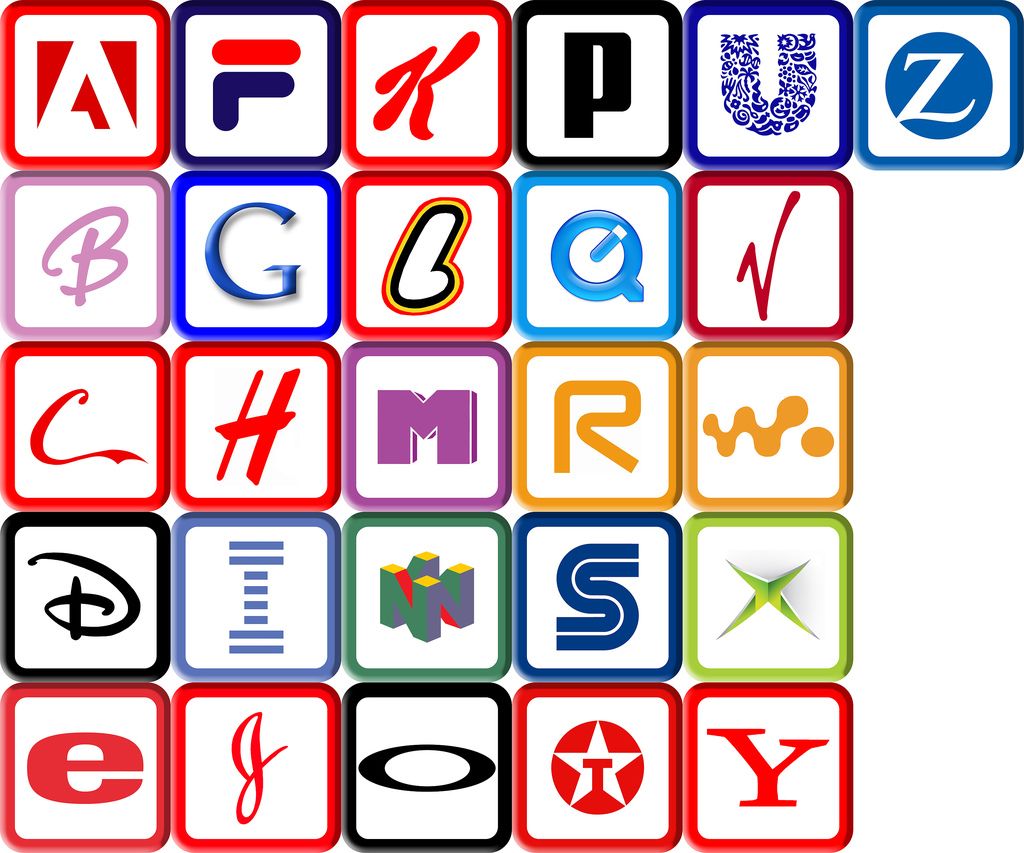
![38% of a message is transmitted via a person's voice; 7% of a message comes from our words; 55% of a message is sent via non-verbal signals (posture, facial expression & hand movement.]](https://books.lib.uoguelph.ca/app/uploads/sites/61/2021/08/image14-1.jpeg)
